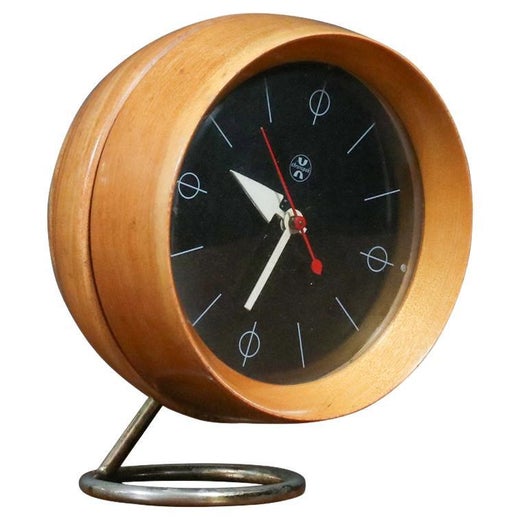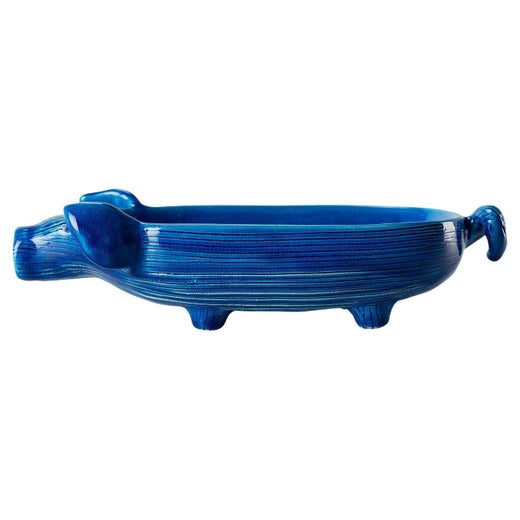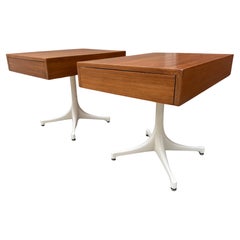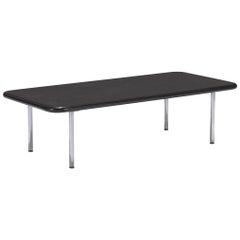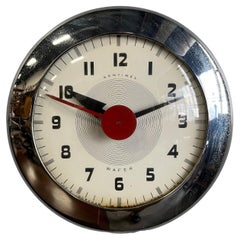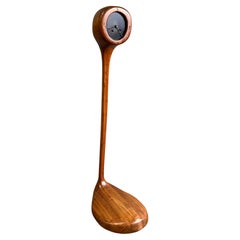Meridian Clock for Raymor Designed by George Nelson
About the Item
- Creator:
- Dimensions:Height: 1.25 in (3.18 cm)Diameter: 14 in (35.56 cm)
- Style:Mid-Century Modern (Of the Period)
- Place of Origin:
- Period:
- Date of Manufacture:1950s
- Condition:Wear consistent with age and use.
- Seller Location:BROOKLYN, NY
- Reference Number:1stDibs: LU179324273623
George Nelson
Architect, designer, and writer George Nelson was a central figure in the mid-century American modernist design movement; and his thoughts influenced not only the furniture we live with, but also how we live.
Nelson came to design via journalism and literature. Upon receiving his bachelor’s degree in architecture from Yale in 1931, he won the Prix de Rome fellowship, and spent his time in Europe writing magazine articles that helped bring stateside recognition to Ludwig Mies van der Rohe, Gio Ponti, Le Corbusier and other canonical modernist architects.
In the 1940s, Nelson wrote texts that suggested such now-commonplace ideas as open-plan houses, storage walls and family rooms. D.J. De Pree, the owner of the furniture maker Herman Miller, was so impressed by Nelson that in 1944 — following the sudden death of Gilbert Rohde, who had introduced the firm to modern design in the 1930s — he invited Nelson to join the company as its design director. There Nelson’s curatorial design talents came to the fore.
To Herman Miller he brought such eminent creators as Charles and Ray Eames, Isamu Noguchi, and the textile and furniture designer Alexander Girard. Thanks to a clever contract, at the same time as he directed Herman Miller he formed a New York design company, George Nelson & Associates, that sold furniture designs to the Michigan firm. Nelson's studio also sold designs for clocks to the Howard Miller Clock Company, a manufacturer that was initially part of Herman Miller before it became an offshoot that was helmed by Howard Miller, D.J. De Pree's brother-in-law.
Nelson’s New York team of designers (who were rarely individually credited) would create such iconic pieces as the Marshmallow sofa, the Coconut chair, the Ball clock, the Bubble lamp series and the many cabinets and beds that comprise the sleek Thin-Edge line.
For dedicated collectors, as well as for interior designers who look beyond “the look,” there is a “cool factor” inherent to vintage pieces from George Nelson and others. Nelson was in on it from the start, and it’s valuable to have a piece that was there with him.
But still, as is evident from the offerings from dealers on 1stDibs, in any of the designs, in any iteration whose manufacture Nelson oversaw and encouraged, there are shining elements of lightness, elegance, sophistication — and a little bit of swagger. George Nelson felt confident in his ideas about design and didn’t mind letting the world know.
Bitossi
Like a Fellini movie, the ceramics of the famed Italian company Bitossi Ceramiche embody a creative spectrum that ranges from the playful and earthy to the high-minded and provocative. Based in Florence, Bitossi draws on craft traditions that date back to the 1500s. These find expression in Bitossi pottery that includes artisanal vintage vases and animal figures by the firm’s longtime art director Aldo Londi, as well as the colorful, totemic vessels designed by the high priest of postmodernism, Ettore Sottsass.
Bitossi was incorporated by Guido Bitossi in 1921, though the family began making art pottery in the mid-19th century. In the 1930s, Londi came aboard, bringing with him a mindset that respected time-honored craft, yet looked also to the future. On the one hand, Londi’s perspective fostered the making of Bitossi’s popular whimsical cats, owls, horses and other animal figures, hand-shaped and -carved and finished in a rich azure glaze known as “Rimini Blue.”
But with his other hand, Londi reached out to thoughtful, experimental designers such as Sottsass. After hiring Sottsass to design ceramics for his New York imports company, Raymor, American entrepreneur Irving Richards connected the Milanese design polymath to Londi, who introduced Sottsass to ceramics in the 1950s.
During that decade, some 20 years before he founded the Memphis postmodern design collective in Milan, Sottsass used the Bitossi kilns to create timeless works that manifest both primitive forms and modern geometries. In later decades, Bitossi would welcome new generations of designers, which have included such names as Ginevra Bocini and Karim Rashid.
While always looking forward, Bitossi is firm in their belief that mastery of craft is the first step towards beautiful design. As you will see from the works offered on these pages, that is a winning philosophy.
Find a collection of vintage Bitossi decorative objects, lighting and serveware on 1stDibs.
You May Also Like
Vintage 1950s American Mid-Century Modern Table Clocks and Desk Clocks
Metal, Brass
Vintage 1950s American Mid-Century Modern Table Clocks and Desk Clocks
Metal, Brass
Mid-20th Century American Mid-Century Modern Wall Clocks
Metal
Vintage 1950s American Mid-Century Modern Table Clocks and Desk Clocks
Metal, Chrome
Vintage 1970s American Mid-Century Modern Wall Clocks
Brass
Vintage 1950s American Mid-Century Modern Table Clocks and Desk Clocks
Brass
Vintage 1950s American Mid-Century Modern Wall Clocks
Brass
Vintage 1960s American Mid-Century Modern Wall Clocks
Rattan
Mid-20th Century American Mid-Century Modern Wall Clocks
Metal
Vintage 1950s American Mid-Century Modern Clocks
Steel
More From This Seller
View AllMid-20th Century American Mid-Century Modern Side Tables
Aluminum, Enamel, Steel
Mid-20th Century American Mid-Century Modern Coffee and Cocktail Tables
Granite, Steel, Chrome
Mid-20th Century American Mid-Century Modern Wall Clocks
Chrome
Mid-20th Century American Mid-Century Modern Grandfather Clocks and Long...
Walnut
21st Century and Contemporary American Mid-Century Modern Sofas
Aluminum, Steel, Chrome
Vintage 1930s American Mid-Century Modern Table Clocks and Desk Clocks
Metal
Recently Viewed
View AllRead More
A Guide to Herman Miller’s Most Iconic Furniture
The prolific manufacturer has partnered with many of the world’s top designers since opening its doors in 1923. Here are some of the company’s greatest hits, which helped transform the American home and office.
Kule and Forsyth Give Iconic Furniture a Bold Makeover with Stripes
Maggie and Anne Genovese, of Forsyth, teamed up with fashion designer Nikki Kule to reimagine some classic pieces.
